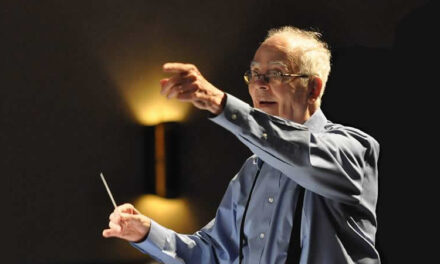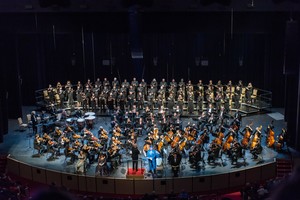There’s a reason why the Paul Taylor dance Company has always received the pride of place as the concluding act at the American Dance Festival. One can always expect quality ensemble and solo work and variety in choreography with a broad audience appeal. Taylor’s system of programming is similar to that of a symphony orchestra or chamber music ensemble: three works consisting of a lightweight opener, a “challenging” contemporary piece and a grand classic finale. Taylor is only offering one program this season, as opposed to the two he used to alternate. It pretty much follows the pattern.
Company B is a 15-year-old Taylor popular classic, a loose-limbed jitterbug replete with bobby socks, danced to nine W.W.II vintage songs by the Andrews Sisters, beginning with “Bei mir Bist Du Schön” and including “Pennsylvania Polka, “Tico Tico,” “Boogie Woogie Bugle Boy of Company B” and others). It’s a cute piece with lots of sight gags, each of the nine movements (ten, including a reprise on movement 1, “Bei Mir Bist Du Schön”) cleverly acting out key lyrics from the song on which it is based. Because of its themeand the tempo of most of the upbeat songs, the dancing itself is pretty tame, There is an opportunity for some male atheletic dancing, especially by Robert Kleinendorst as the Boogie Woogie Bugle Bot of Company B. I enjoyed it in spite of myself, since I entered Page Auditorium feeling the bitter irony between this paean to the “good war” and the Andrews Sisters themselves, who toured tirelessly with the USO to boost troop morale, and the one we’re stuck in now. Maybe Taylor meant for us to feel that way, especially in light of the second work on the program.
Dante Variations, premiered in 2004, is based on Canto III of Inferno where Virgil and Dante view the souls at the vestibule of hell who have spent their lives as moral fence-sitters, and “lived without infamy or praise.” They are denied entrance into either heaven or hell, despised by both For eternity, pursued by stinging wasps and hornets, they follow a banner that moves aimlessly in front of hell’s gate.
Dante Variations consists of ten movements, each one featuring a dancer encumbered either physically or emotionally, symbolizing an excuse for inaction. As the curtain opens the cast is piled on the floor in a heap, gradually jerked into motion by invisible strings. Then the various “excuses” unfold: Annmaria Mazzini performs a solo with her hands tied behind her back; Robert Kleinendorst dances encumbered by a piece of cloth tied to one ankle that inhibits everything he attempts to do (baggage); Amy Young plays passive victim to the men in the cast, and so on. In the culminating movement – not surprisingly a fugue – each of the dancers enters in an individual way but quickly conforms to the rigid movements of the rest of the cast, eventually all landing back in their heap.The jerky marionette motions provide a thematic movementfor the entire piece, which is accompanied by tuneless music by György Ligeti adapted for a gurgling barrel organ. The use of the dancers’ giant shadows against the back of the stage and reptilian skin-tight costumes betrays Taylor’s debt to Gustave Doré’s famous illustrations of the Commedia. Here was a dance with choreographic and symbolic meat, executed to perfection – and a warning to all of us?
What a letdown, then, for the much anticipated world premiere, Spring Rounds! This piece is one of Taylor’s signature balletic numbers, a pretty, asymmetrical array of free-flowing movement in various permutations and combinations of dancers, to the accompaniment of Richard Strauss’s Divertimento, Op. 86 based on music by Couperin. Taylor is, of course, noted for matching his choreography impeccably with the music, as well as keeping his dancers’ movements as artistic extensions of their natural counterparts. When Taylor does this kind of thing well, you get Esplanade; when he doesn’t, you get modern dance “lite.”












